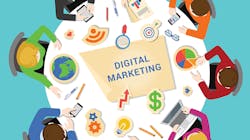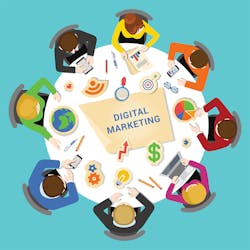Nearly six months after the United States first went into lockdown due to the coronavirus, the business world is far from what it was pre-pandemic. In what has been often referred to as “the new normal,” businesses are working harder to bring in sales, while battling a tough, but seemingly recovering economy; the threat of furloughs or layoffs; sick or fearful employees; and additional safety precautions.
David Gordon, president, Channel Marketing Group, has been exploring the effects of coronavirus on the electrical industry since the beginning of the pandemic on his website (www.electricaltrends.com), in addition to partnering with DISC Corp. on multiple COVID-19 electrical distribution sentiment surveys.
He says over the past six months, companies have had to endure and adapt their business. Even with the most optimistic vaccine predictions, mass inoculations likely wouldn’t occur until mid-next year. Companies will need to continue to adapt, while also having plans that enable them to capture business for the next 18 months assuming that the COVID environment doesn’t change.
However, Gordon believes what the electrical industry is experiencing is less of a “new normal” and more of the “next evolution,” since the pandemic has accelerated change in so many areas. Despite the many challenges presented by the pandemic, it has also granted opportunities for creativity, as electrical distributors and independent manufacturers’ rep agencies experiment with new, unique marketing and sales strategies that help their companies find success and adapt toward this next evolution.
Since the pandemic will likely not be going away anytime soon, it’s more important now than ever before to take a step back, examine current sales and marketing practices in the scope of a continually digitalized world, and decide what changes — if any — need to be implemented. The editors of Electrical Wholesaling spoke to both industry veterans and newcomers to seek the top 10 tips on how to flourish in this post-pandemic, very virtual electrical industry.
#1: Pick up a camera or smart phone. One of the most common — and successful — marketing practices to come out of the pandemic is bringing products to customers via video format. Flynn & Reynolds Agency, Inc., a manufacturers’ rep agency based in Tewskbury, MA, has found massive success with its new video campaign, launched by President Greg Reynolds and his daughter, Becky Reynolds, a junior at Bryant University in Rhode Island who is interning at the company. The company had previously experimented with videos before she began interning, says Becky, but they were quite long and just explained a product with little action.
“I told him, ‘We should be more interactive, like pick a product that you can install or something,’” she shares. “And our videos ended up being way more successful. The first one we posted got 3,000 views, so then we realized that was the path that we needed to go on.”
While some of their videos don’t rake in quite as many views, the average video they post may attract several hundred views, along with comments and shares, helping encourage more people to click “like” on Flynn & Reynold’s LinkedIn page.
“To the 3,000 views, I mean, we couldn’t duplicate that with a hundred people out in a year,” adds Greg.
#2: Be consistent and patient. R/B Sales Corp., a manufacturers’ rep agency based in Marion, IA, is also finding success through its own video campaign. One of the biggest successes of their video campaign, shares Bill Devereaux, president, is their consistent branding within the videos, which they post on both the company’s LinkedIn and Facebook pages. “Our videos have a very constant beginning, and it’s a 3D wooden box bouncing up and down, breaking open with the R/B Sales name (logo),” he says, adding that this consistent branding was conceived by their marketing intern, Erin Pitz, who is also a rising senior at the University of Iowa. He says their goal is that within three seconds, viewers know the video is by R/B simply by recognizing that bouncing wooden block and logo.
And while it may be tempting in this virtual setting to want to post videos constantly, it’s worthwhile to set a slower — albeit consistent — posting schedule. Flynn & Reynolds posts about every two weeks, according to Becky, who discovered that LinkedIn’s algorithm allows an individual video to continue getting views, likes, and shares for nearly two weeks after its original posting date.
#3: Get everyone involved. Change can be challenging, especially with the stress of the pandemic weighing on nearly everyone. But keeping up company morale is important not only to help employees feel valued, but also to help any new marketing or video campaigns be more successful. “People are hesitant to try something new,” says Pitz, who began her internship shortly after the pandemic shut everything down. “A lot of people are like, ‘I don’t want to put my face on a video!’”
It’s important to make everyone feel comfortable and heard, so in this instance, they had a salesperson create a video using a screen-share method to show the audience how to customize an LED hybrid on Shat-R-Shield’s website. The salesperson shared her screen as she chose the wattage, mount type, lens and more.
“It was really quick and easy,” Pitz adds, who has been instrumental throughout the company’s social media, video and email campaigns.
For Flynn & Reynolds, keeping everyone involved while working from home was also one of the major drivers behind making their videos. Greg wanted his employees to have fun and enjoy this new process, so they created the “Flemmy” competition, short for a “Flynn & Reynolds Emmy.”
“We gave one out for the person who did the best, and we voted amongst the whole group of us,” Greg shares. “We’ve had fun with it.”
#4: Remember to tag and share. For Becky, one of the biggest keys to a successful video post was tagging those involved, including Flynn & Reynolds and especially the product’s manufacturer. This helps drive likes to its LinkedIn page. “Once we started tagging manufacturers, we started getting way more views because people in the manufacturers who work there were more likely to see it,” she says.
“It gets infiltrated throughout the whole hierarchy,” adds Greg about the videos. “It sells Flynn & Reynolds back up to the manufacturer. We’ve seen, in some cases, some of our videos have gotten comments back from very senior people within the organizations.”
Additionally, both her and Greg encourage Flynn & Reynolds employees to share the videos on their personal pages, which increases overall likes for each video and continues to bring more awareness to the company’s page from each person’s individual connections.
#5: Keep it short. At the start of the pandemic, Gordon witnessed many companies move into the video platform, from narrated home-grown videos to hour-long webinars. While they worked early on during the pandemic when sales calls were greatly reduced and people weren’t as busy, he warns that long videos and daily webinars won’t be as effective moving forward.
“There comes a point on how much watching TV you can do,” Gordon says. “Because that’s really what you’re doing if you’re just sitting in on webinars hour after hour after hour.”
Both R/B Sales’ and Flynn & Reynold’s examples show shorter is almost always better — so try keeping videos at only a few minutes long, especially those that get posted to social media. This keeps viewers engaged.
#6: Connect on a personal level. Dan Riedell, vice president of operations for R/B Sales, says the pandemic reminded the R/B Sales team of the importance of human connection. From the beginning of the crisis, Devereaux sent out weekly letters to establish rapport with their customer base, he said.
“It didn’t have to be strictly work related, but it was about building that rapport and building that camaraderie at a time when people were just questioning what was going on,” Riedell says. “And they didn’t have to be heavily laden business material, but it was stuff we could relate to our everyday lives.”
Devereaux adds that these correspondences — which consist of stories ranging from him meeting President George W. Bush at a NEMRA event to how he first got into the electrical industry — have actually helped better the relationships R/B Sales has with distribution and the management within the manufacturers they represent.
#7: Be aware of analytics. Another one of Pitz’s major objectives during her internship was to create an email campaign for R/B Sales’ customers. When someone signs up, she explains, they can click which manufacturers they want to hear news from or simply select general R/B Sales news.
But for an email campaign to be as successful as possible, analytics are necessary. They employ data analytics to track data from their newly fledged email campaign. “What we’re trying to understand is if people are more minded to spend time or click on one thing versus another,” says Devereaux.
Patience is also necessary, as analytics require time before they can really inform users of what’s working and what isn’t. “It’s still pretty fresh,” Pitz says of the campaign. “So, I think in a couple months or so, we’ll be able to see what it’s doing for us and how we can improve it even more.”
#8: Move quickly. Nowadays, so many companies are active online, whether it’s through email or video campaigns, social media, etc. That means moving quickly — and, more importantly, being the most knowledgeable source out there — is vital.
When the pandemic first shut everything down in March, Devereaux says more end-users, including industrial, OEMs and contractors, came directly to R/B Sales instead of going through the traditional distributor channel to get information. He believes it’s linked directly to people being under-resourced and needing the right information quickly. “I believe this is critical for agencies to communicate to the people they need to communicate with as quickly as possible, because right now information is power,” he said.
#9: Leverage the mailbox. While some in-person sales meetings are beginning to resume, it seems likely virtual meetings will still be a primary means to conduct sales calls moving forward. However, that doesn’t mean you can’t get sample products to potential customers.
Greg and Becky Reynolds from Flynn & Reynolds say another way they’ve increased viewership on their videos while also getting in sales calls is sending out samples to potential customers and end-users. The samples chosen were ones they had already made videos for, so included with the product was a how-to flyer and a QR code the user could scan to watch the video.
“We’re able to have a sales call when they get that sample sitting on their desk,” Greg says. He adds that while it’s a different method of reaching people that he may not have traditionally tried, he finds it to be less expensive and a more creative way to still get in that sales call.
#10: Act smart, not scared. Companies need to keep experimenting with new sales and marketing strategies, despite the challenges brought on by the pandemic. Gordon says that during a recession, the traditional business management response is to cut all expenses. But if companies do that now with all of their sales and marketing, it will reduce their visibility in the marketplace. “Out of sight, out of mind,” isn’t a good strategy right now, he says. “There are statistics out there and anecdotal information out there that says if you market and are aggressive in recession, you come out of them faster and at a higher rate,” he adds.
Gordon also adds that it pays to consider in-person meetings in an environment that he calls “Zoomed out,” because of fatigue with teleconference calls. He says it’s important for salespeople to first determine the customer’s level of comfort with in-person meetings. They should find out if customers are okay with in-person meetings with masks, if they prefer meetings outside of their facilities, etc. Even customers’ comfort level with handshakes must be a consideration.
Additionally, it’s also worth considering what products are going to be especially important — and thus sell — in a post-pandemic world. Gordon cites products such as touchless lighting and controls, motion activated sensors, remote diagnostics or ultraviolet germicidal disinfection products.
For example, Lutron Electronics has created various digital sell sheets featuring its touchless solutions, rapid response capabilities, and vertical market sell sheets highlighting its wireless solutions. “Touchless solutions are now especially important as building owners and facility managers look to update their properties to reduce risk and enhance feelings of security for employees and visitors,” says Thomas Perich, director of channel marketing – electrical distribution.
Similarly, Riedell believes while it’s important for companies to get back to in-person meetings one day, they shouldn’t forget what they’ve learned throughout the pandemic, either. “The most successful companies will be able to integrate what we’ve done during the pandemic and what’s going to come after,” Riedell says. “We’ll be able to integrate those technologies and relationships in a way that is actually more profitable, more beneficial, more effective.”
As a company, they don’t expect marketing to ever go back to the traditional ways. For example, the last thing Riedell wanted was for Pitz to just make flyers. “That’s not what marketing is anymore,” adds Devereaux, echoing Riedell’s sentiments. “If you need a flyer made, go to the manufacturer. They probably have one you can use. In our industry, too much of our marketing is flyers.”
But regardless of all the challenges COVID-19 has thrown at businesses, electrical industry veterans interviewed for this article say this industry is resilient. “I tell all of my people the electrical industry is not going away regardless of what happens in the marketplace,” says Greg. “People are going to need electric lights, and they’re going to need heat, and they’re going to need to power their facilities.”
Perhaps most important right now is to not only work smart, but also to remain optimistic. “We’re going to keep a positive attitude and not let the negatives pull us down,” Greg concludes.



